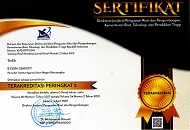PENGEMBANGAN KURIKULUM PTAI YANG TERKAIT DAN SEPADAN DENGAN KURIKULUM MADRASAH
Abstract
One of the most important agenda of in education todai is to establish such a link-and-match curriculum among levels or educational institution and among educational institution, workfield, and stakeholders. To realize such a desired curriculum among levels or educational institution, the visions, missions, curriculum and characteriustics of the instituions should be comprehensively understood. The process of the curriculum development may follow the following steps: (1) identifying factors or determinats that contribute to the curriculum development and conducting need analysis as well, (2) identifying the desired competency and profile of the graduates, (3) deciding knowledge, affection, and skills which are neede to build such competency, (4) designing the structure of the curriculum and establishing link and match, and (5) developing syllabus. In developing curriculum, especially in achieveing a link-and-match curriculum, the following principles should be implemented: relevance, continuity and integration.
Kata Kunci: pengembangan kurikulum, kurikulum madrasahFull Text:
PDF (Bahasa Indonesia)References
Andi Haris Prabawa, Siti Zuhriah. (ed). (2002). Paradigma Pengembangan Kurikulum Tahun 2002. Surakarta: Muhammadiyah University Press.
Ansyar, M. (2003). Hakekat Kurikulum Berbasis Kompetensi: Implemen-tasi pada Kurikulum Pendidikan Tinggi. (Makalah Seminar Kuri-kulum Berbasis Kompetensi IAIN Imam Bonjol Padang).
Brady, Laurie (1992). Curriculum Deve-lopment. New York: Prentice Hall.
Departemen Agama RI. (1998). Kuri-kulum Madrasah ‘Aliyah Tahun 1994: Landasan Program, Prog-ram dan Pengembangan. Jakarta: Dirjen Binbaga Islam Depag RI.
E. Mulyasa. (2002). Kurikulum Berbasis Kompetensi: Konsep, Karakteris-tik, dan Implementasi. Bandung: Remaja Rosdakarya.
Fasli Jalal. (2002). Sambutan Pem-bukaan Seminar Nasional KBK di UNP. Padang.
Hamid Hasan. (2002). Hakekat Kuri-kulum Berbasis Kompetensi. (Ma-kalah dalam Seminar Nasional KBK UNP).
Husni Rahim. (2001). Arah Baru Pen-didikan Islam di Indonesia. Jakarta: PT. Logos Wacana Ilmu dan Pemikiran.
Nana Syaodih Sukmadinata. (1997). Pengembangan Kurikulum: Teori dan Praktek. Bandung: Remaja Rosdakarya.
-------(2003). Dasar-Dasar Pengem-bangan Kurikulum perguruan Tinggi. (Makalah dalam Lokakarya Pengembangan Kurikulum Ber-basis Kompetensi IAIN Sunan Gunung Jati Bandung).
Rose, Colin & Malcom J. Nicholl. (2002). Accelerated Learning For The 21 st Century. Bandung: Nuansa.
Sinar Grafika. (2003). Undang-Undang RI Nomor: 20 Tahun 2003 tentang Sistem Pendidikan Nasional. Jakarta.
Soediyarto. (1993). Memantapkan Sis-tem Pendidikan Nasional. Jakarta: PT. Gramedia Wirasarana.
Tilaar, H.A.R. (1998). Beberapa Agenda Reformasi Pendidikan Nasional: Dalam Perspektif Abad 21.
Tyler, Ralph W. (1949). Basic Principle of Curriculum and Instruction. Chicago: Chicago Press.
DOI: http://dx.doi.org/10.31958/jt.v12i2.160
Refbacks
- There are currently no refbacks.
Copyright (c) 2016 Syafruddin Nurdin

This work is licensed under a Creative Commons Attribution-NonCommercial-NoDerivatives 4.0 International License.
TA'DIB with registered number e-ISSN: 2580-2771, p-ISSN: 1410-8208 have been indexed on:

Journal Ta'dib distribute under Lisensi Creative Commons Atribusi-NonKomersial 4.0 Internasional.
Contact us: Ta'dib; Address: FTIK, Universitas Islam Negeri Mahmud Yunus Batusangkar; Jl. Sudirman No. 137 Lima Kaum Batusangkar, Tanah Datar, Sumatera Barat, Indonesia. Email: takdib@uinmybatusangkar.ac.id

























